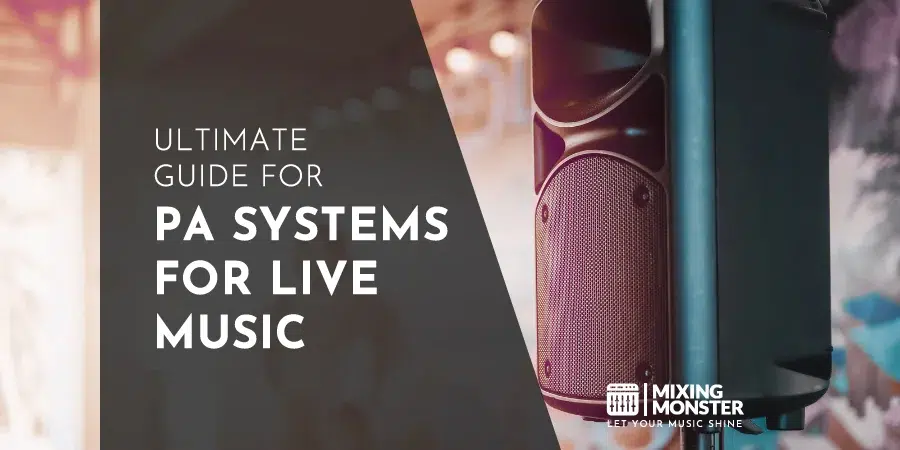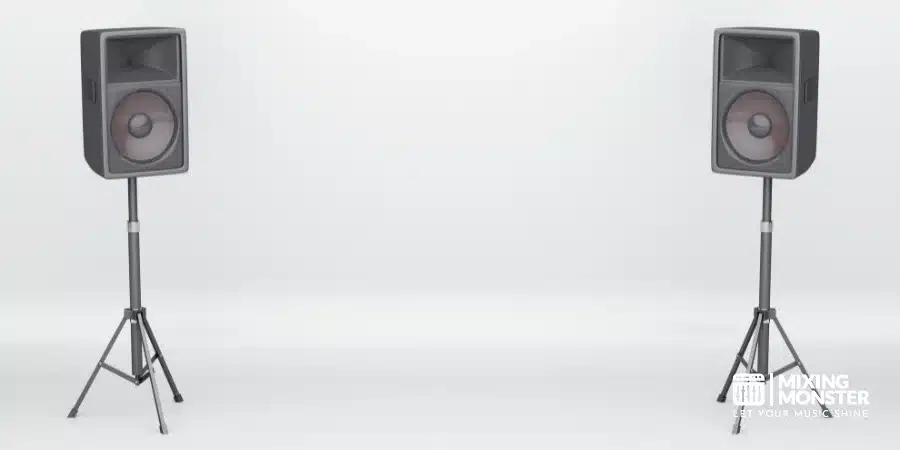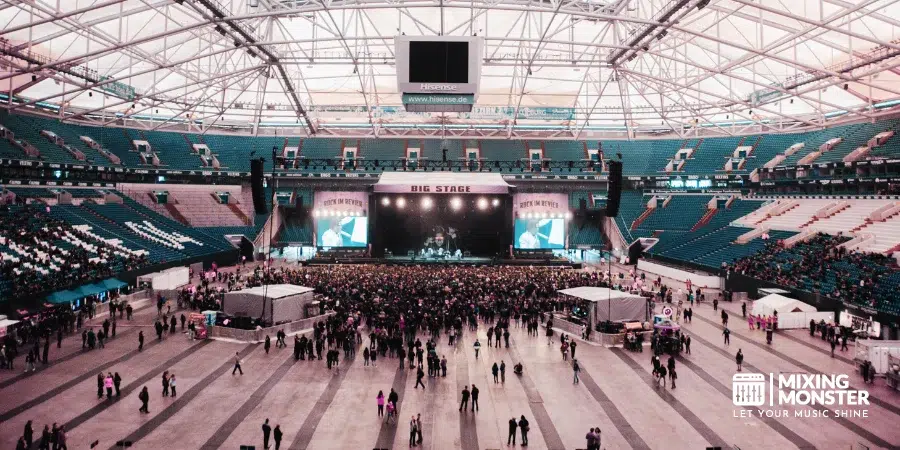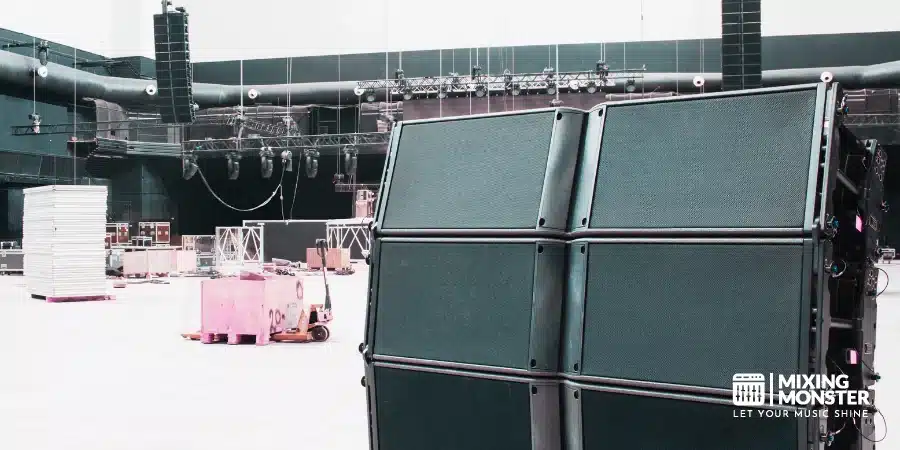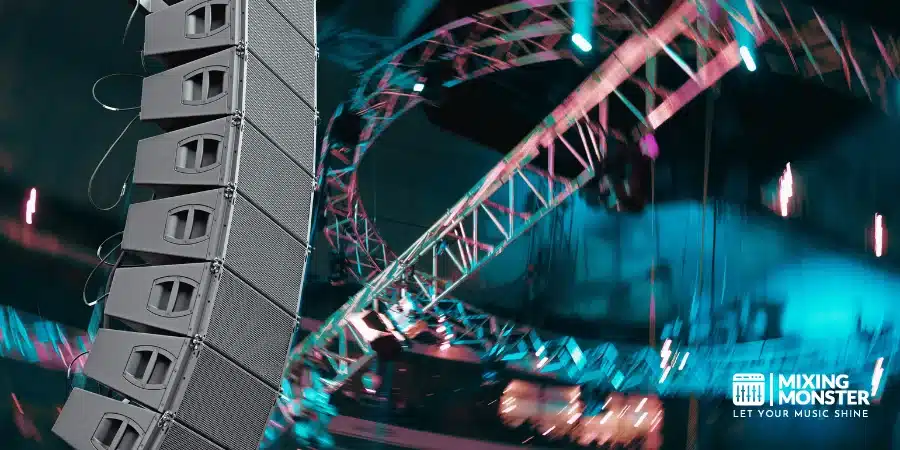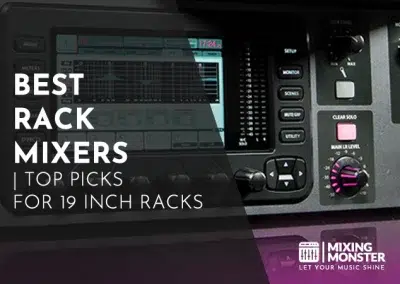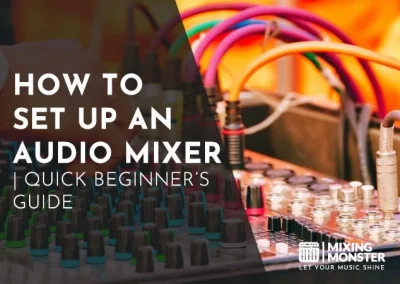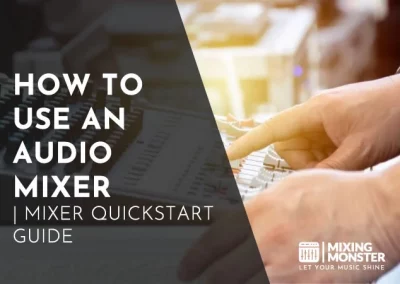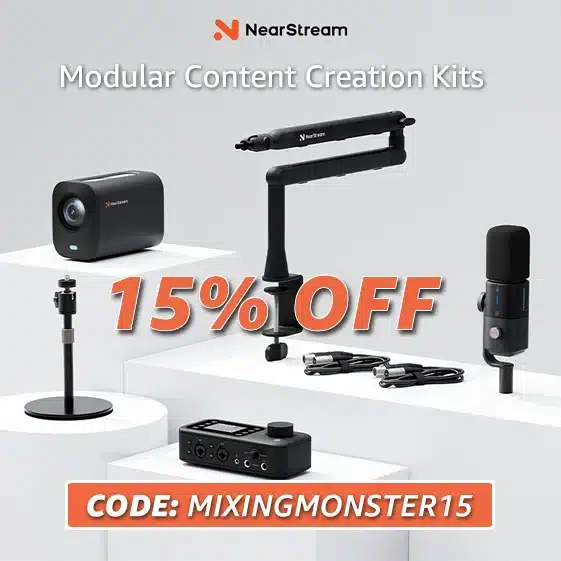Home > Blog > Studio Gear > Music Gear
Disclosure: Some of the links below are affiliate links, meaning that at no additional cost to you, we will receive a commission if you click through and make a purchase. Read our full affiliate disclosure here.
Let’s be honest—no live event, concert, or even a simple talk really gets off the ground without one thing: clear, reliable sound.
A PA system (short for “public address system”) is a combination of microphones, amplifiers, and speakers that work together to amplify sound for a group. It is the backbone that makes sure every note and every word lands with the crowd, no matter how massive or tiny the venue might be.
Its whole point? To get voices and music out there so everyone—whether front row or back wall—gets the same audio experience. These days, PA systems can range from grab-and-go wireless kits to massive rigs for large, complex events.
Picking one isn’t just about plugging stuff in; you’ve gotta think about the space, those weird acoustic quirks, and essential components like mixers, speakers, and feedback prevention gadgets.
Let’s be real: a PA system’s quality can totally make or break a performance or speech. Whether you’re a musician, event planner, or the sound tech everyone’s counting on, knowing the basics is a game-changer.
This guide delves into the nitty-gritty—key components, setup tips, and practical advice for maximizing sound quality in your system. We’ll also check out what’s new. Curious how a solid PA setup can transform your show and keep the crowd hooked? Let’s dive in.
KEY TAKEAWAYS:
- PA systems are what keep audio crisp and clear, no matter the venue.
- Choosing the right gear? It significantly impacts your sound and the reliability of things.
- Setup, upkeep, and modern features matter way more than you’d expect.
Table Of Contents
1. PA Systems Overview For Live Music
2. Choosing The Right PA System For Your Venue
3. Essential PA System Components Explained
4. Setting Up Your PA System For Live Music
5. Optimizing Sound Quality And Preventing Feedback
6. Portable And Wireless PA Systems For Musicians
7. Maintenance And Longevity Of PA Systems
8. Trends In PA Systems For Live Music
9. Key Takeaways For PA Systems For Live Music
FAQ

1. PA Systems Overview For Live Music
PA systems are what push clear sound out to crowds, whether you’re in a tiny bar or a massive stadium. Their job—boosting and spreading live sound—is pretty much vital for both the people on stage and everyone listening.
What Is A PA System And Why Is It Essential?
A Public Address (PA) system is a bunch of electronic gadgets that amplify audio so bigger crowds can hear. For live music, PA systems make sure everyone—whether they’re right up front or way in the back—gets the vocals and instruments loud and clear.
Without proper amplification, performers would struggle to reach the back row, especially in a large venue. PA systems help keep everything balanced and avoid that nasty feedback or distortion that can ruin a show.
Musicians and sound engineers rely on PA systems to get their sound across the way they intended. They’re just crucial to modern venues and outdoor gigs, no question.
Key Components Of Modern PA Systems
A modern PA system isn’t just one thing—it’s a bunch of parts working together to make live sound happen:
- Mixers:
These blend signals from mics and instruments, tweak volume, tone, and balance. You’ll find both analog and digital types, and some mixers have a remarkably high number of channels for complex gigs. - Amplifiers:
These take the weak audio signals and pump them up so the speakers can actually do their job. - Speakers:
The Main speakers blast sound out to the audience. Monitors point at the performers so they can actually hear themselves (trust me, that’s huge). - Microphones and DI Boxes:
These grab vocals and instruments with as much detail as possible. - Signal Processors:
Tools like compressors and EQs help smooth things out, maintain steady volume, and ensure the tone’s just right.
Many top-tier PA systems include subwoofers for that deep, punchy bass—something that’s often a must for specific music genres, in our opinion.

How PA Systems Have Evolved For Live Music
PA systems have changed a ton, keeping up with what modern live music and huge venues demand. Back in the day, setups were pretty barebones—just basic amps and horn speakers, and the sound? Eh, not great.
Now you’ve got compact, lightweight gear, digital mixing, and networked systems for crazy-precise control. Digital mixers often come loaded with effects, multi-track recording, and even wireless remote control.
Brands have gotten way smarter about sound reinforcement, too—think line array speakers that spread sound evenly, even in weird-shaped spaces. Plus, stuff like built-in feedback killers, auto EQ, and slick signal routing make it way easier for engineers to handle tricky setups without losing their minds.
Common Types Of PA Systems Used
There are a few main types of PA systems, each fitting different live music situations and venue needs:
- Portable PA Systems:
Small, all-in-one rigs—perfect for solo acts or tiny venues. They’re lightweight and can be set up in minutes. - Modular PA Systems:
These are made of separate pieces like mixers, speakers, and amps. You can scale them up for bands or midsize spaces, which is pretty handy. - Line Array Systems:
Stacks of speakers in vertical lines—these give a strong, even sound at festivals or big concerts. - Install Systems:
Custom setups built for permanent spots like theaters or churches, tuned for the best possible sound.
What’s best depends on your venue size, the music, and what the performers or event need from a technical angle.
2. Choosing The Right PA System For Your Venue
Picking a PA system? It all starts with knowing your venue’s size, what kind of event you’re running, and, yeah, your budget. All those things change what kind of sound, gear, and setup you’ll need—whether it’s a party or a loud live show.
Assessing Venue Size And Acoustics
How big (and weirdly shaped) your venue is makes a massive difference for your PA needs. Big, open rooms may require beefier speakers and possibly a couple of extra subs to fill the space with sound.
Small places? You can usually get away with a compact all-in-one system—just right for more intimate gigs. The room’s shape, ceiling height, and even what’s on the walls can totally change how sound bounces around.
Lots of glass or hard surfaces? That’ll bounce sound everywhere and cause echoes. Hanging up curtains or slapping on some wall panels can help tame those issues a lot.
Here’s a quick checklist:
- Measure the room (length, width, height).
- Look for big reflective surfaces.
- Figure out where people will actually be. This simple prep really helps you match the space to the proper PA setup.
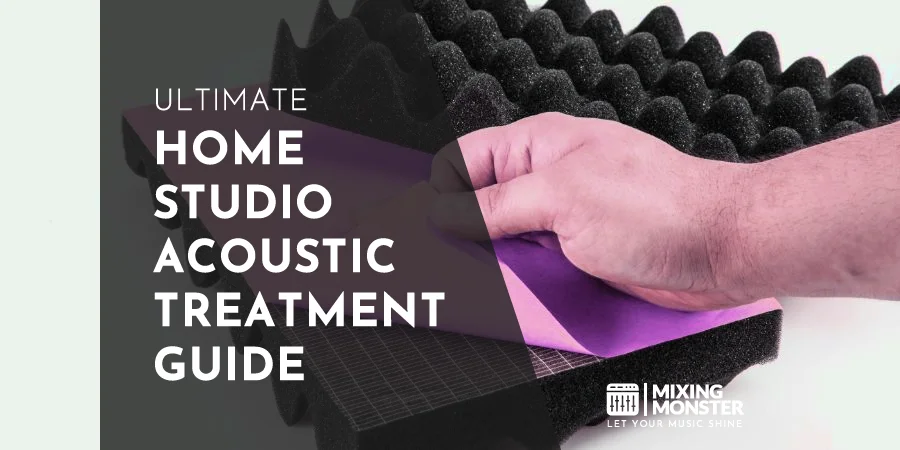
Matching PA System Power To Audience Size
Audience size tells you how much power you’ll need. For up to 50 people—think small venues or private parties—a PA with 100–300 watts RMS usually does the job.
Medium gigs need 500 watts or more. Got a big crowd? You’re looking at 1000+ watts and several speakers.
Here’s a rough guide:
| Audience Size | Recommended Power (RMS) |
|---|---|
| Small (up to 50) | 100–300 watts |
| Medium (51–200) | 300–1000 watts |
| Large (200+) | 1000+ watts |
Power needs also depend on your music style, how clear you want speech, and whether you’re indoors or out. You want clean, undistorted sound all the way to the back—nobody likes muddy audio.
Indoor Vs Outdoor PA System Considerations
Setting up a PA system isn’t really a one-size-fits-all thing—it’s pretty different indoors versus outdoors. Inside, sound tends to bounce off the walls and ceiling, so you’ve gotta keep an ear out for echoes and weird reflections that can muddy things up.
Step outside, though, and it’s a whole new ballgame. Sound disappears faster, plus wind and random background noises can really mess with your mix. You’ll usually need more power, and directional speakers can be a lifesaver for open-air setups.
And don’t forget: outdoor gigs often need weather-resistant gear. Extension cords, cable covers, and putting stands under a canopy or tent can keep everything safe if the weather turns. Wireless mics? They’re great for avoiding the classic “trip over a cable” move.
The weather and size of your space will usually dictate how many speakers you’ll want, where to put them, and whether portable or battery-powered systems make sense—especially if you’re nowhere near an outlet.
Budgeting For Your PA System Investment
PA system prices are all over the place. You might spend as little as $200 for a basic, portable rig for a backyard party, but if you want a professional setup with serious power and features, it can easily cost $3,000 or more. What really pushes the price? Power, expandability, portability, and those nice extras like built-in mixers or Bluetooth.
When you’re figuring out what to spend, focus on the stuff that matters most to you:
- Enough power for your crowd and space
- Reliable microphones and solid stands
- Inputs for all your gear—don’t forget the laptop or phone!
Choosing the right PA system is really about balancing your budget with what you’ll actually use. Renting is honestly a good call for one-off events. Spend smart—you don’t want to end up with a system that’s too weak, or drop cash on a bunch of features you’ll never touch.

3. Essential PA System Components Explained
Most PA systems rely on a handful of core components. If you know what each part does, you’ll have a way better shot at getting solid, clear sound no matter what you’re doing.
PA Mixing Consoles: Analog Vs Digital
The mixing console—or just “the mixer”—is where all your audio sources come together. Analog mixers are straightforward, featuring real knobs and faders, and many people find them more intuitive, especially for live mixing.
Digital mixers, though, bring a bunch of handy features like scene recall, built-in effects, and deep channel control on digital screens. Many modern digital mixers even let you mix wirelessly from a tablet or laptop, making soundchecks and tweaks significantly easier.
Analog mixers are usually cheaper and quicker to learn, but digital ones win hands-down for flexibility if you’re running a bigger or more complicated show. When picking a mixer, think about how many channels you’ll actually use, whether you’ll need phantom power for condenser mics, and, honestly, what feels best in your hands.
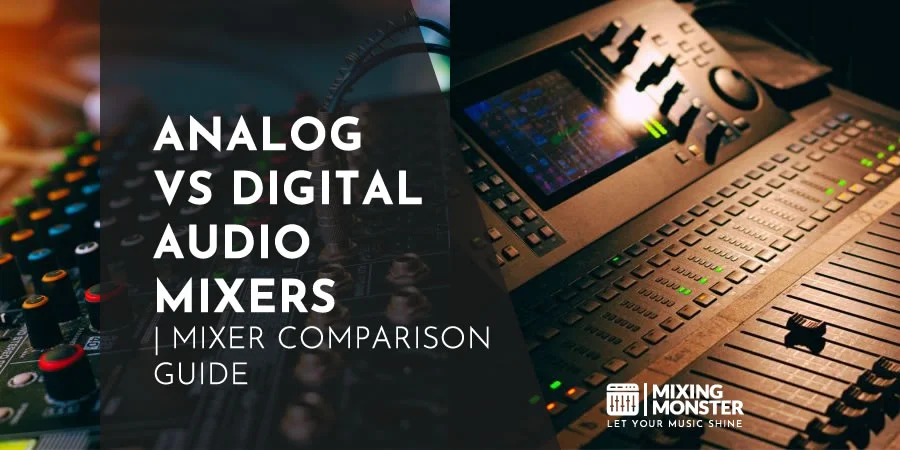
PA Speakers And Subwoofers For Live Sound
Speakers are the stars of the show—they’re what your audience actually hears. The quality of your speakers makes a huge difference in how crisp and wide your sound is.
Full-range speakers usually cover most of what you need, but if you’re playing bass-heavy music or working in big spaces, powered subwoofers add that deep, chest-thumping punch. When you’re shopping, look at wattage, coverage angle, and whether you want active (amp built-in) or passive (needs external amp) setups.
Subwoofers are a must for DJs and bands who want the crowd to feel the low end. For a deeper dive into system types, take a look at the components of a public address system.
Microphones And Wireless Solutions
Microphones are where it all starts—they turn voices and instruments into signals for your mixer. Dynamic mics are tough as nails and work well for vocals or instruments in louder settings.
Condenser mics, which require phantom power, capture more detail and are ideal for studio-style vocals or acoustic instruments. Wireless mics? They give performers space to move and keep the stage way less messy.
Most modern wireless systems operate on digital signals for clear audio and are designed to minimize interference from other electronic devices. It’s worth matching your microphone types and wireless gear to your style and stage setup so you don’t encounter dropouts or unexpected issues mid-show.
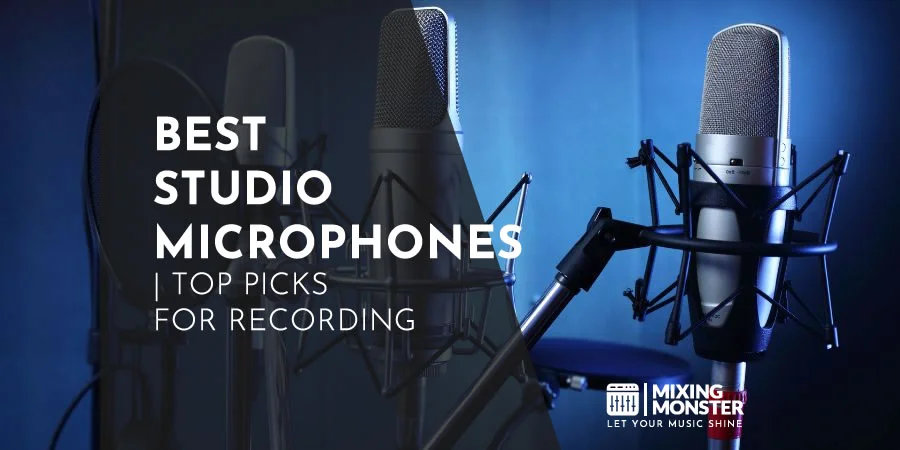
Amplifiers, Processors, And Signal Flow
Amplifiers are what give passive speakers and subs the juice they need, boosting the signal from your mixer so people can actually hear it. You’ve gotta match your amp’s power to the speakers—otherwise, you’ll get distortion, or worse, blow something up.
Powered speakers come with amps built in, which makes life easier, especially for smaller or portable rigs: less gear to lug around, fewer cables to mess up.
Signal processors—things like equalizers, crossovers, and compressors—help shape and protect your sound. They keep things clear, balance out the frequencies, and stop your gear from getting overloaded.
When your signal flows smoothly—from mic to mixer, through amps and processors, out to the speakers—you’ve got a system that works together. That’s really what makes live sound reliable and solid.
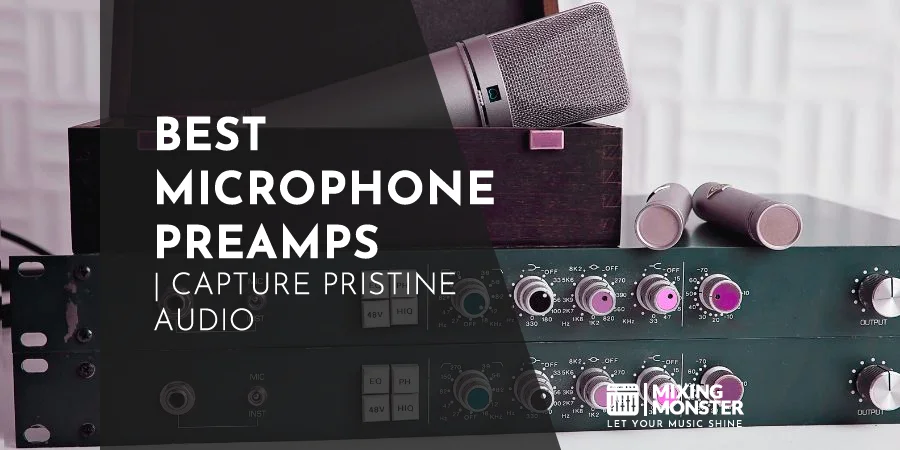

4. Setting Up Your PA System For Live Music
Achieving great sound and a setup you can trust begins with assembling your PA system correctly. Paying attention to little things—such as connections, where things go, and calibration—can save you from annoying signal issues and keep everything sounding good for the crowd.
Step-By-Step Setup Process
First, ensure you have all the necessary gear: a mixer, power amplifiers (if you’re using them), speakers, and all the required cables. Place the mixer somewhere you can easily see the performers—it makes mixing during the show much easier.
Plug mics and instruments into their channels using balanced XLR or TRS cables to keep noise down. Connect your mixer’s main outs to powered speakers or your amps, then amp outputs to passive speakers if that’s your setup. For smaller acts like duos or DJs, stereo channels keep things simple.
Always turn on the mixer before the speakers—trust me, nobody wants to hear those nasty pops. Bring up each input one by one and set the gain so nothing distorts or feeds back. That’s your base for clean sound. For more information, refer to this step-by-step PA system setup guide.
Cabling And Wiring Best Practices
Use good, shielded cables to keep buzz and interference out of your sound. Try to run power and audio cables separately to avoid ground loops or hum.
Label both ends of every cable—it’ll save you a significant amount of time setting up and tearing down. Cable ties or Velcro straps are your friends for keeping things neat and safe. If space is tight—like for a duo or DJ—short, organized cables keep the chaos down.
Check connectors now and then for wear, and swap out anything sketchy. If you have to run cables across walkways, use ramps or gaffer tape so nobody trips. Solid cable management really cuts down on those mid-show emergencies.

Speaker Placement And Room Coverage
Set your speakers up at ear level and aim them away from the mics to avoid feedback. In smaller rooms or for duos, aim for even coverage without overpowering the folks in the front row.
Don’t put speakers right against walls or in corners—otherwise, you’ll get boomy, muddy bass. For larger venues or DJ sets, consider adding extra speakers as fills or delays to accommodate those further back. Angle them out for a nice stereo spread so everyone gets a good listen.
Walk around while music’s playing and listen for dead spots or weird volume drops. If you find any, adjust the angles or add another speaker where necessary. No shame in moving things around until it feels right.
Soundcheck And Calibration Techniques
Start the soundcheck with everything muted, then bring up each mic or instrument one at a time. Set the gain so you’ve got a strong signal, but nothing’s peaking—watch those channel meters!
Tweak the EQ on your mixer to fix feedback or weird room resonances. A graphic EQ is super helpful for knocking out problem frequencies, especially as things get louder. Set up monitor mixes so performers can hear themselves and each other—seriously, it makes a huge difference.
Walk around during calibration, listen from different spots, and tweak the volume and tone as needed. Test both quiet and loud to make sure your PA holds up when the show’s in full swing. There’s more advice in this PA system configuration guide if you want to go deeper.

5. Optimizing Sound Quality And Preventing Feedback
Achieving consistently good sound from a PA system requires a combination of solid technique, careful adjustments, and, honestly, patience. You’ve got to keep an ear on feedback, clarity, and how vocals or background music fit together if you want things to sound polished and pro.
EQ And Effects For Live Music
EQ really is the backbone of clear sound—it’s what lets you balance all those instruments and vocals so nothing gets lost (or too loud). High-pass filters?
They’re your best friend for cutting out that low-end rumble, especially on vocal mics. If you dial back the muddiness or harsh sibilance in the midrange, everything sits much better in the mix. Trust me, it makes a difference.
Reverb and compression? Absolute essentials. Compression smooths out the loud and quiet bits, so you don’t get those jarring jumps or lose the softer details. Just a touch of reverb can give vocals and instruments some space, but if you go overboard, good luck understanding the lyrics.
The trick is to use EQ and effects carefully—keep the background music present, but don’t let it swallow the live sound. There’s a balance, and it’s not always easy to find.
Monitor Mixes For Performers
Monitor mixes are what let musicians and singers actually hear themselves on stage. When each performer gets a mix tailored to them, they don’t have to crank up the volume—resulting in less feedback, cleaner stage sound, and, honestly, everyone feels more comfortable.
You can go with floor wedges, in-ear monitors, or side fills—it just depends on the gig and what’s available. Each mix should include the essentials: lead vocals, rhythm, and any necessary cues, but avoid overloading it.
In-ear monitors are also a lifesaver for hearing protection and blocking out distracting noise, allowing everything to stay sharp and focused.
Feedback Prevention Strategies
Feedback—that awful squeal—occurs when a microphone picks up sound from a speaker and loops it endlessly. To keep it from happening, always keep mics behind the main speakers and use directional mics that cut out most of the background noise.
Mute or lower any unused mic channels, avoid cranking the gain, and keep mics close to whoever’s using them. Feedback suppressors or a dedicated EQ can help you hunt down those problem frequencies.
If you want more ideas, these guides on eliminating microphone feedback and stopping feedback on PA systems are worth a look.
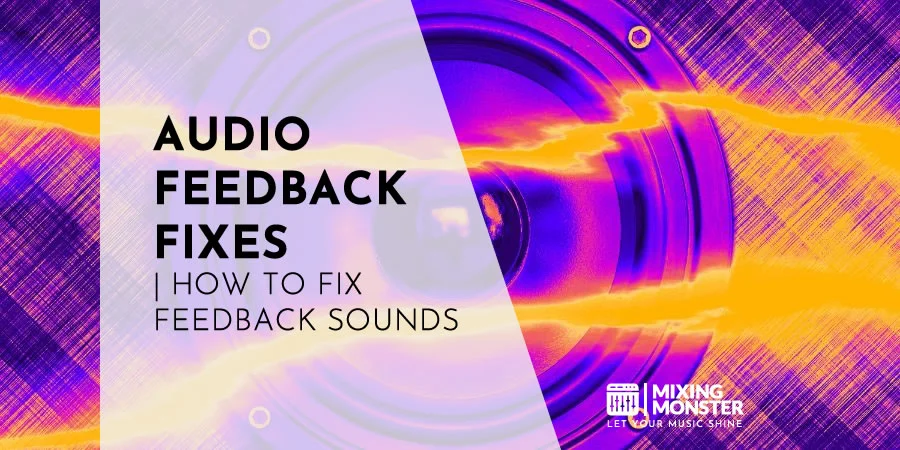
Troubleshooting Common Live Sound Issues
Live sound always finds a way to throw you a curveball—hum, distortion, a signal just vanishing for no reason. Figure out if it’s a bad cable, some weird routing, or just the gain set way too high, and you’ll save yourself a lot of headaches (and probably some embarrassment).
Keep your cables organized, check your gear regularly, and have a signal flow diagram nearby. If things start getting muddy or feedback pops up, try muting channels one at a time or use a test tone to hunt down the problem.
Just taking things one step at a time keeps you from panicking and helps you maintain good sound quality for both vocals and background music.
6. Portable And Wireless PA Systems For Musicians
Portable and wireless PA systems make it ridiculously easy for musicians to set up live sound just about anywhere—no fuss, no drama. With Bluetooth, built-in batteries, and compact designs, these are essentially a must-have if you’re constantly gigging in new spots.
Benefits Of Portable PA Systems
A portable PA system is built for easy transport and quick setup—perfect for parks, coffee shops, pop-up shows, and more.
Here’s why musicians actually love these things:
- Mobility:
They’re lightweight and compact, so you can grab ’em and go. - Versatility:
Most have multiple inputs—mics, instruments, even tracks from your phone. - Fast setup:
Fewer cables, simple controls, and less time spent fiddling mean more time playing. - All-in-one design:
Battery-powered models throw a mixer, amp, and speaker into a single box.
Solo acts, buskers, and small bands especially appreciate these perks—let’s be honest, not everyone has a sound tech tagging along.
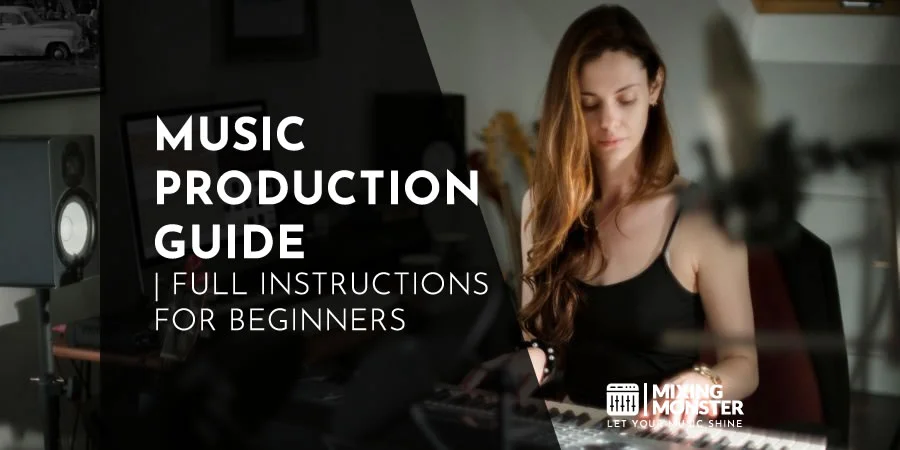
Top Wireless PA Solutions
If you want solid wireless, go for systems with reliable Bluetooth and wireless mic support. The Bose S1 Pro+ and Electro-Voice Evolve 30M get a lot of love for their sound and how easy they are to lug around.
- Bose S1 Pro+:
Bluetooth streaming, rechargeable battery, and an easy-carry handle. - Electro-Voice Evolve 30M:
Advanced DSP, an eight-channel mixer, and a lightweight column array. - Mackie Thump GO:
Wireless app control and flexible placement options.
With wireless capabilities in these PAs, you can run tracks or break music directly from your phone or tablet—control it from wherever you are on stage. Pretty handy, honestly.
Battery-Powered Options For Gigging
Battery-powered PAs mean you can play where there’s not a single power outlet in sight. Stuff like the Roland Cube Street EX, Bose S1 Pro+, and Mackie Thump GO are all about portability and making your life easier.
Here’s what to look for:
- Up to 6-12 hours of playtime on a single charge.
- Rechargeable or quick-swap battery packs.
- Clear, punchy sound for small to mid-sized crowds.
Most of these have multiple inputs and built-in effects too, so you get a full performance rig that fits in your trunk—perfect for gigging, busking, or just rehearsing wherever you feel like.
Transport And Setup Tips For Musicians
When selecting a portable PA, look for features such as built-in handles, padded bags, and durable cases to keep your gear safe while you’re on the move.
A couple of quick setup tips:
- Color-code or label your cables—it makes setup way faster.
- Set speakers at about head height for the best sound coverage.
- Charge all your batteries before the gig—bring spares if you can swing it.
- Use a wheeled cart for heavier gear or long hauls.
Most new systems like the Mackie Thump GO and Bose S1 Pro+ are clearly designed with musicians in mind—ergonomic handles, quick-mount stands, and setups that take just minutes. Good transport and setup habits keep your sound consistent and your stress level low, wherever you find yourself playing next.

7. Maintenance And Longevity Of PA Systems
Taking care of your PA system means it’ll last longer, sound better, and save you from those gear fails that always seem to happen at the worst possible time. Regular maintenance is worth it to protect your investment.
Cleaning And Caring For Your Equipment
Keep every part of your PA system clean if you want it to last and keep performing. Dust and grime can build up inside speakers, mixers, and amps, making them overheat or sound weird. Wipe down surfaces with a dry, lint-free cloth—skip the harsh chemicals, they can mess up finishes or even fry electronics.
Check vents, fans, and grilles for dust, and use compressed air to blast out the hard-to-reach spots. Keep an eye out for corrosion on connectors or terminals, especially if you’re gigging in humid places.
Coil your cables neatly and store them properly to avoid kinks and breakage. Look for frayed or loose ends, and swap out any dodgy cables as soon as you notice them. Keeping things clean and organized cuts down on technical problems and helps your gear run smoother, longer.
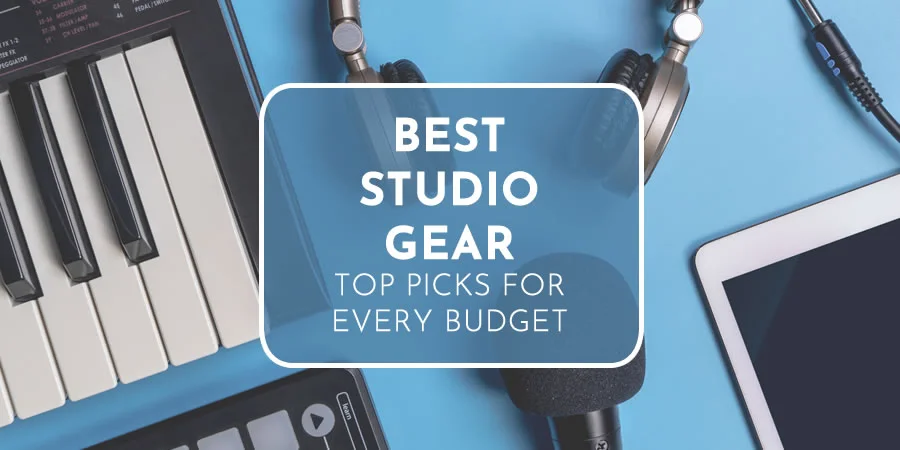
Regular Maintenance Schedules
If you want your PA system to keep working like it should, regular maintenance is a must. Here’s a quick checklist of the basics (honestly, skip these and you’ll probably regret it):
- Check cables, connectors, and plugs for any visible damage, wear, or loose ends.
- Test audio from every single speaker—don’t assume they all sound the same. Distortion or weird imbalances can sneak up on you.
- Clean filters, fans, and vent grilles. Dust builds up fast, and you really don’t want overheating issues mid-show.
- Tighten up racks, stands, and all those small fasteners that tend to loosen over time.
- Double-check that everything works—mics, control panels, the whole system.
A lot of places—schools, venues, whatever—bring in a tech once or twice a year for a deeper look. Public buildings usually stick to a strict preventative schedule, like the one in the ET07 preventative maintenance schedule, checking all the connections and components.
Upgrading And Expanding Your PA System
Sometimes your PA just doesn’t cut it anymore. You may be playing bigger spaces, or you’ve got more people using the system—time for an upgrade.
First thing: make sure any new gear actually works with what you already own—amps, mixers, speaker impedance, the boring but essential stuff. If you’re adding speakers or wireless mics, plan out where they’ll go so you don’t end up with a spaghetti mess of cables.
Most newer systems are modular, so adding on isn’t usually a nightmare. Still, check if your cables can handle the extra load, or if you’ll need to run new ones (yeah, that’s never fun).
Don’t forget about software and firmware updates—those can make a real difference in performance and security. Thinking ahead a bit can save you a lot of hassle (and money) later.
Troubleshooting And Repair Resources
When things go sideways, acting quickly is your best bet for keeping the show running. Start simple: check connections, power, and each piece—speakers, mics, mixers, whatever’s in the chain.
Listen for feedback, missing audio, or just odd noises. Most gear comes with a manual that’s got a troubleshooting section (yeah, it’s worth a look). Some companies, like SCIEX, even have downloadable guides (see the official PA 800 Plus maintenance guide).
If you’re stuck or the problem’s deep inside the electronics, don’t mess around—call a pro. Keeping a maintenance log is also a good idea. You’ll spot patterns and ensure that nothing gets overlooked.
For complicated setups, bringing in specialists can mean faster fixes and regular updates. Sometimes it’s just easier to let the experts handle it.
8. Trends In PA Systems For Live Music
PA systems for live music are evolving at a wild pace. Engineers keep coming up with smarter, more eco-friendly, and flexible gear, which makes live music sound better, easier to set up, and hey, it’s a bit kinder to the planet, too.
Latest Innovations In PA Technology
Honestly, PA tech has leveled up. Speakers are smaller (finally), but the sound? Way clearer, with better frequency range than you’d expect.
Now you’ve got built-in digital signal processing (DSP) that handles feedback, EQ, and real-time tweaks on its own. Wireless control is everywhere—performers can adjust mixes right from their phones or tablets, which is pretty cool.
Line array setups used to be for massive arenas, but now you see them at smaller gigs and with more reasonable price tags. Modern PA innovations include built-in mixers, lighter cases, and battery-powered options for outdoor shows—finally, no more fighting for outlets.
AI And Smart PA Systems
AI is starting to really shake things up in PA systems. Some newer models use AI to scan the room and automatically adjust EQ, dynamics, and feedback—no more endless tweaking.
Smart PAs can sense the size of the crowd and adjust the sound field, so everyone gets a good mix. Automated mixing means techs or performers can balance levels hands-free, which is a lifesaver for small acts.
AI diagnostics sometimes spot and fix issues before you even realize something’s off. Makes live shows a whole lot less stressful.
Sustainability And Eco-Friendly Equipment
PA brands are actually trying to be greener these days. Newer models use recyclable cabinets and energy-efficient Class-D amps that don’t overheat and waste less power.
It’s beneficial for the planet, and it’s also more cost-effective for tours and venues. Some companies are making speaker bags and accessories from recycled materials, which is a nice touch.
Battery-powered PAs now use lithium-ion batteries—way better than those old lead-acid ones, both for lifespan and less waste. More eco-friendly packaging and trade-in programs for old gear are also emerging.
PA Development Predictions For The Next Years
Looking forward, digital tech is only going to get more important. Expect PA systems that plug right into networked audio setups with zero hassle.
Adaptive sound will use machine learning to adjust itself as the crowd or room changes. More systems will lean on app controls and touchscreens, so even non-tech folks can get pro-level sound.
With remote and hybrid events everywhere, there’s going to be more demand for PAs that handle live streaming and recording straight out of the box. The future for PA systems is looking smart, lightweight, energy-efficient—and honestly, just a lot more reliable.
9. Key Takeaways For PA Systems For Live Music
Getting the right PA system set up is huge if you care about clear sound at live events. Matching your system to your space and music style saves you from all those annoying audio headaches.
Core components: mics, mixers, amps, and speakers. Every piece matters if you want your sound to come through the way you imagined.
Key points to keep in mind:
- Always factor in venue size. Small rigs are suitable for coffee shops, but large halls require substantial power.
- Good cables and connectors are your first defense against signal dropouts. Don’t cheap out here.
- There’s a PA for every need—portable kits for small gigs, pro systems for big concerts.
- Speaker, monitor, and mic placement can make or break your sound. It’s not just about volume—avoid feedback and keep the crowd happy.
| Feature | Small Venue | Large Venue |
|---|---|---|
| Speaker Power | Lower wattage | High wattage |
| System Type | Compact/portable | Modular/professional |
| Setup Complexity | Simple | Advanced |
PA systems aren’t just about being loud—they’re about capturing, processing, and delivering sound, which is why they’re so essential for live music events.
When shopping for a PA, think about durability, sound quality, and how the features stack up against the price. Accessories like stands, covers, and monitors can really level up your setup—sometimes it’s the little things that make the difference.

FAQ
1) What components are included in a complete PA system package?
A typical PA package includes speakers, a mixer or amplifier, microphones (wired or wireless), speaker stands, and all the necessary cables. Some newer kits even add Bluetooth and USB features.
Portable and battery-powered systems might include rolling cases or covers. Larger venue packages usually throw in monitors and signal processors, too.
2) Which portable PA systems offer the best wireless microphone performance?
The best portable PAs for wireless mics give you solid connections and barely any interference. Brands like Bose, JBL, and Yamaha are pretty much the go-to for reliability and sound clarity.
UHF wireless mics tend to have better range and fewer dropouts than VHF, so they’re a favorite for most events. Many of the top PA systems allow you to add extra microphones if you need to expand.
3) How do the features of different PA system speakers compare?
PA speakers come in all shapes and sizes, and honestly, there’s a lot to think about—power, frequency response, size, and whether you actually want to lug them around. Something like the Bose S1? That’s a single-speaker setup, super compact, and honestly, you can grab it and go.
If you’re aiming for bigger venues, those larger stereo rigs definitely pump out more volume and deeper bass. These days, it feels like almost every new speaker tosses in built-in amps, EQ, and even Bluetooth. It makes things easier.
Oh, and don’t forget speaker stands—they really do help throw sound further, especially if you’re dealing with a big room.
4) What should one consider when looking for PA systems for sale?
Shopping for a PA? Pay attention to wattage, ease of movement, the number of inputs you get, and extras like wireless or Bluetooth capabilities. Ask yourself where you’ll set it up and what kind of events you’re planning to run.
Durability matters too, and a good brand with solid support can save you headaches down the road.
5) What are the key factors in determining the best PA system for my needs?
Consider what you’ll actually use it for, the number of people you’ll be playing with, the room’s acoustics, and the type of connections you’ll need. For smaller gigs, you might be totally fine with something compact and battery-powered—why overcomplicate it?
If you’re doing live music or outdoor events, you’ll want more power and a few extra channels. Taking the time to look at setup options and flexibility really helps you land on the best PA system for whatever you’ve got in mind.
6) What benefits do PA systems with Bluetooth capability provide?
With a Bluetooth-enabled PA system, you can stream audio straight from your phone, tablet, or laptop—no need to mess around with extra cables. Honestly, it takes a lot of the hassle out of setting things up.
Bluetooth gives you way more flexibility, too, especially at events where you might want to switch between different audio sources. Swapping devices or playlists takes, what, a couple of seconds? It’s super convenient when you want to keep the momentum going.

